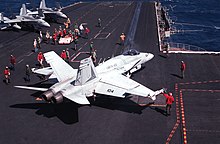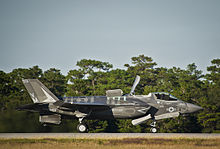VMFAT-501
| Marine Fighter Attack Training Squadron 501 | |
|---|---|
F-35B Lightning II |
Marine Fighter Attack Training Squadron 501 (VMFAT-501) is a training squadron in the
History
World War II
Marine Fighting Squadron 451 (VMF-451) was activated on 15 February 1944 at
The squadron moved on board
1950s

On 1 July 1946, the "Fightin’ Phillies" were reactivated as a reserve unit at
In October 1954, VMF-451 upgraded to the North American
1960s & 1970s
While at MCAS El Toro, VMF-451 upgraded from the FJ-4 Fury to the supersonic Vought
On 24 August 1965, VMF(AW)-451, with the AJ tailcode, deployed aboard
1980s & 1990s

In 1984, VMFA-451 set a safety record of 29,000 accident-free hours in the Phantom. After 21 years in the venerable "Rhino", and led by Alfred Cunningham award winner Lieutenant Colonel T.D. Seder, the "Warlords" exchanged their McDonnell Douglas F-4S Phantom II for the
On 23 August 1990, VMFA-451 deployed to
VMFA-451 spent the remaining six years leading up to deactivation on the East Coast, making periodic deployments that included exercises in Norway. They returned from the Western Pacific in late July 1996, and from there, wound down a 57-year history. The "Warlords" of VMFA-451 were deactivated on 31 January 1997.
Reactivation as a training squadron

On 1 April 2010, the squadron was reactivated and redesignated as VMFAT-501 at a ceremony at the
Initially stationed at
VMFAT-501 moved back to its permanent home of MCAS Beaufort in July 2014 and now falls under MAG-31 both administratively and operationally.
September 2018 crash
On 28 September 2018, A F-35B crashed near MCAS Beaufort in which the pilot safely ejected.[7] The entire F-35 fleet was grounded to inspect all F135-PW-600 engines. An investigation found the cause was a manufacturing defect in an engine fuel tube which would rupture and cause loss of power.[8] This was the first crash of a F-35.
See also
- United States Marine Corps Aviation
- List of inactive United States Marine Corps aircraft squadrons
- List of active United States Marine Corps aircraft squadrons
Notes
![]() This article incorporates public domain material from websites or documents of the United States Marine Corps.
This article incorporates public domain material from websites or documents of the United States Marine Corps.
- ^ "The Mojave Virtual Museum - The "Mojave Marines": Life at MCAAS Mojave". Mojave Transportation Museum. Archived from the original on 3 November 2007. Retrieved 25 June 2008.
- ^ Arrington, PFC Samantha H. (15 April 2010). "History in the making: First F-35B Lightning II squadron stands up". United States Marine Corps. Archived from the original on 29 June 2011. Retrieved 1 April 2020.
- ^ "Official Website for Marine Fighter Attack Training Squadron 501". United States Marine Corps. Retrieved 6 January 2010.
- ^ Thomas, Capt Craig (16 November 2009). "Joint Strike Fighter lands closer to Corps' air arsenal". Headquarters Marine Corps. United States Marine Corps. Archived from the original on 19 January 2011. Retrieved 1 April 2020.
- ^ "Factsheets: 33rd Fighter Wing". United States Air Force. Archived from the original on 27 December 2010. Retrieved 6 January 2010.
- ^ "Marine Unit Reborn". Pensacola News Journal. Archived from the original on 2 April 2015. Retrieved 4 April 2010.
- ^ Phillips, Patrick (29 September 2018). "Pilot ejected before military plane crash in Beaufort Co., deputies say". live5news.com. Retrieved 24 January 2022.
- ^ "F-35 Joint Strike Fighter - Action Needed to Improve Reliability and Prepare for Modernization Efforts" (PDF). Retrieved 22 December 2023.
References
- Bibliography
- Crowder, Michael J. (2000). United States Marine Corps Aviation Squadron Lineage, Insignia & History - Volume One - The Fighter Squadrons. Paducah, KY: Turner Publishing Company. ISBN 1-56311-926-9.
- Condon, John Pomeroy (1998). Corsairs and Flattops - Marine Carrier Air Warfare, 1944-45. Annapolis Maryland: Naval Institute Press. ISBN 1-55750-127-0.
- Rottman, Gordon L. (2002). U.S. Marine Corps World War II Order of Battle - Ground and Air Units in the Pacific War, 1939 - 1945. Greenwood Press. ISBN 0-313-31906-5.
- Sherrod, Robert (1952). History of Marine Corps Aviation in World War II. Washington, D.C.: Combat Forces Press.
- Web


